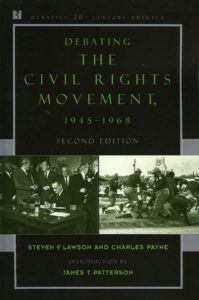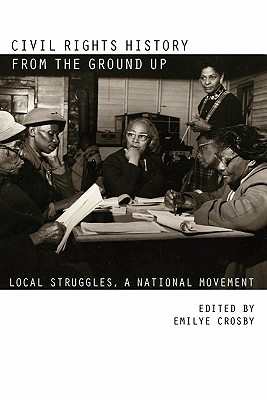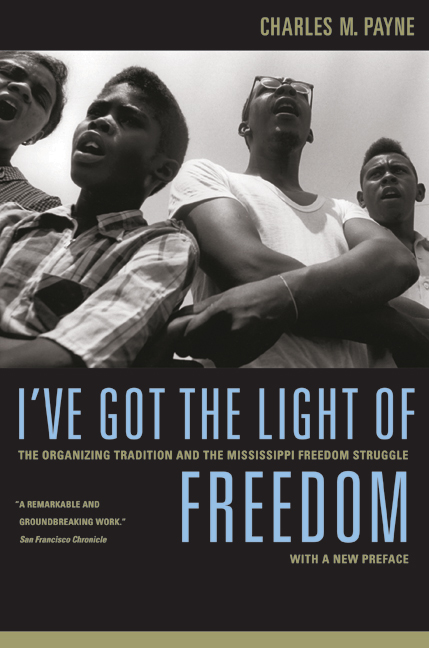No other book about the Civil Rights Movement captures the drama and impact of the black struggle for equality better than Debating the Civil Rights Movement, 1945 — 1968.
Two of the most respected scholars of African-American history, Steven F. Lawson and Charles M. Payne, examine the individuals who made the movement a success, both at the highest level of government and in the grassroots trenches.
Designed specifically for college and university courses in American history, this is the best introduction available to these turbulent times. Carefully chosen primary documents augment each essay, giving students the opportunity to interpret the historical record themselves and engage in meaningful discussion. [Publisher’s description.]
Read excerpt about the master narrative.
ISBN: 9780742551091 | Rowman & Littlefield Publishers
Review of the book from H-Net
Reviewed by Derek Catsam (Contemporary History Institute, Ohio University) for H-Net, October 2000
Combine two essays by historians currently at the top of their game with a sampling of primary sources and a brief but important list of sources for further exploration and what do you get? If you are the publishers Rowman and Littlefield you get Debating the Civil Rights Movement, 1945-1968, a useful, readable, and provocative book from a series that aims to bring important current historiographical and methodological debates into undergraduate classrooms. This book is so well done, however, that it is also highly recommended for nonspecialist graduate students and even professors looking to brush up on their civil rights historiography.
James T. Patterson, the general editor of the Debating 20th Century America series, has done an admirable job in selecting Charles Payne and Steven Lawson to write the essays that are central to this book. Both authors are in the process of reaping rewards for their most recent books. Payne’s I’ve Got The Light Of Freedom (1995), on the local struggle for civil rights in Mississippi during Freedom Summer, is a masterful examination of the grassroots struggle for racial equality in the Closed Society that was the Magnolia State. Lawson’s newly republished Black Ballot (1976, 1999) looks at the struggle for voting rights in the South and reveals the role that myriad actors at the national, state, and local levels played in securing passage of the Voting Rights Act and its enforcement. It is this difference of emphasis that provides the springboard for the two essays in Debating the Civil Rights Movement. Payne argues that to understand civil rights, one must look at the grassroots and realize that the struggle was one borne of hardship on the backs and in the hearts of local, often anonymous women and men. Lawson, meanwhile argues that the federal government was vital in securing the rights for which black and white activists clamored.
Of course most scholars in the field would acknowledge that this is not an either-or proposition. And indeed, both Payne and Lawson wisely acknowledge that theirs is a disagreement over the emphasis historians ought to place on the various factors and actors leading to the successes of the post-World War Two period. Payne, while often critical of the government, also acknowledges that it took Congress and the prodding of Lyndon Johnson and other national leaders to codify civil rights in the Civil Rights Act of 1964 and the Voting Rights Act of 1965. Lawson meanwhile acknowledges that without grassroots movement, the federal government would never have felt compelled to act.
The essays are each supplemented with primary documents that are intended to bolster the respective arguments. In the case of Lawson’s arguments “From the Nation,” the reader gets to examine excerpts from the 1947 Truman administration study “To Secure These Rights: The Report of the President’s Committee on Civil Rights,” the 1956 “Southern Manifesto,” excerpts from the U.S. Commission on Civil Rights in 1958, and several others. These documents serve to augment the issues presented in Lawson’s essay. The documents from Payne’s “View from the Trenches” do not cohere quite so well. This section has only five, mostly brief documents, where the other section had nine mostly longer documents. Although Ella Baker’s classic “Bigger than a Hamburger” is excerpted, some of the other documents seem more capriciously chosen. Perhaps a few more documents would have provided a stronger skeleton. Or perhaps the documents should have been chosen to respond more immediately to either the essays or else the corresponding documents for the other side. This is not to say that the documents are not an intriguing addition. It is simply to aver that the essays are so strong that they deserve a better supporting cast.
The book concludes with a reasonably solid list of suggested readings, which is always a welcome addition to any such project, even if we have to admit that most such lists go unacknowledged in the transoms of all but the most conscientious and driven students. This is a list that will provide a solid introduction to the ever-growing literature on civil rights, African-American history, and the politics of race. Most graduate students in modern American history would do well to cover the majority of this list in their reading in the field.
But it is to undergraduates that this book is most relevant. Getting students to understand and appreciate historical debates can be one of the most challenging jobs of a university teacher. In most cases just the mention of the word “historiography” is enough to inspire slackened jaws, vacant stares, and hyperactive salivary glands as students drool onto their notebooks in a stage somewhere between REM sleep and comatose. It is for this purpose that this book, and indeed the whole series, is most welcome. Through the liveliness of the essays, and despite my criticisms, the immediacy of (some of) the documents, students are able to enter sideways into the world of debates and arguments and disagreements and intellectual give-and-take that most intrigues us as historians.
For students taking their first history classes, the format of the book will also allow clear examples of secondary versus primary sources, a difference that is often more difficult to spell out than it ought to be. This book will go a long way toward enabling students to engage not merely in the justifiable typical student moral outrage over Jim Crow, but also to understand that even amongst those engaged in understanding civil rights, there are legitimate and interesting disagreements around which they can form their own ideas. That the debates are not utterly polarized from one another will serve to help students to understand that the shades of gray in historical debate are as important as the obvious disagreements in black and white.
Copyright (c) 2000 by H-Net, all rights reserved. This work may be copied for non-profit educational use if proper credit is given to the author and the list. For other permission, please contact H-Net@h-net.msu.edu. Link to article at H-Net.










Twitter
Google plus
LinkedIn